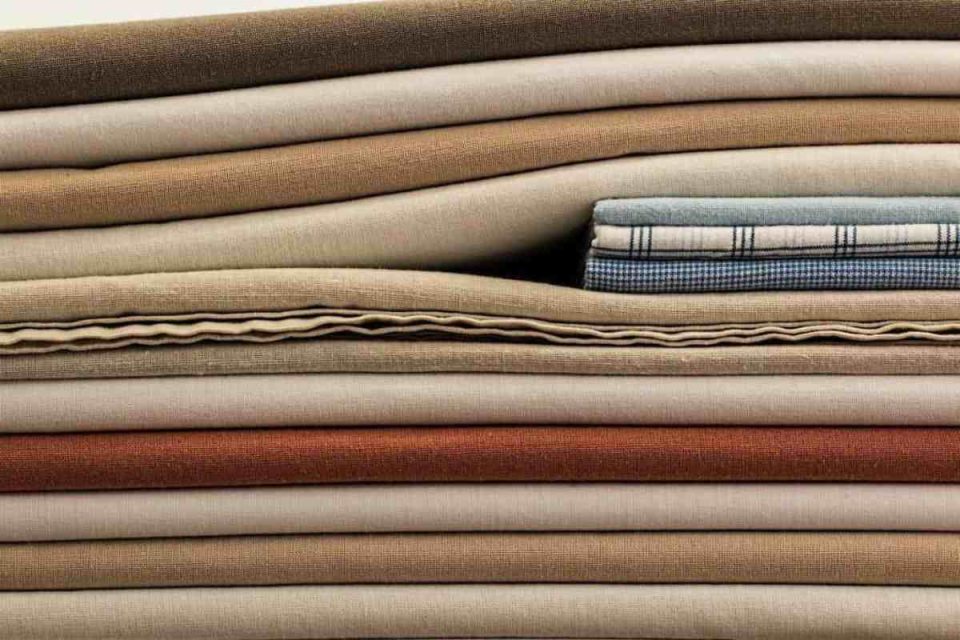Table of Contents
Introduction
What are your criteria for choosing clothing materials? The cut, the material, the price, the quality? Difficult to slice, the most beautiful materials have a high cost but usually have a longer lifespan. Is it possible to find a happy medium?
In today’s article, I propose to sift through the clothing materials to favour their good quality: origin, advantages, disadvantages, you will know everything!
Which Fibres for the Manufacture of a Fabric?
Before I talk about the different materials, I think it is essential to talk about their manufacturing process. Before you transform it into a soft alpaca wool vest or become your favourite jeans, the fabric undergoes many transformations.
As you can imagine, the longer and more complex this process is, the more extraordinary the material in question will be. Without going into elaborate scientific explanations, remember that it is the fibre at the origin of fabric making.
Natural Fibres
Of plant or animal origin, natural fibres come from nature and are produced from plants, animals and sometimes even minerals. We find cotton, the most used fabric in the manufacture of clothing, and linen, wool or silk, for example.
Artificial Fibres
Synthetic or regenerated fibres are usually obtained from cellulose (organic matter) in cotton and, more often, from pine wood. It is the case of rayon, for example.
Artificial fibres (non-cellulosic) are synthesized from molecular elements contained in hydrocarbons. Nylon, polyester and elastane are obtained from synthetic fibres.
Natural Fibres And Synthetic Fibres for clothing Materials: A Cost Story
The manufacture of fabric begins with the extraction of the raw clothing material, the fibre. Once transformed, these fibres are spun and woven and can also undergo unique treatments that will add added value to the fabric. It is called finishing.
You should note that natural fibres require more work and manufacturing time than artificial or synthetic fibres, which are simpler to produce for industries, but also much less expensive.
Polyester is now the second most manufactured fabric after cotton. It is, therefore, not surprising that clothing is often made from a mixture of natural and synthetic fibres.
Advantages And Disadvantages of Choosing Clothing Materials
It would, of course, be too easy to say that natural fibres are preferred over synthetic fibres. On both sides, there are good and bad. From an environmental point of view, natural fibres are biodegradable and can be recyclable.
Nevertheless, producing a fabric such as cotton (non-organic) requires a large amount of water and pesticides, but often also the use of heavy metals, especially for dyeing. For their part, synthetic fibres come from chemical manufacturing processes (similar to plastic) but often bring durability and resistance to clothing.
Most of the clothes we buy contain different types of fibres. However, some materials remain preferred if you are looking for good quality clothes.
Summer is synonymous with lightness. We tend to opt for airy clothes that let the skin breathe and in which we do not sweat. During the day, it is better to favour materials such as cotton or linen, which are elegant and resistant. For the evening, a tiny silk dress will perfectly adapt for comfort and elegance.
Cotton
A timeless classic, challenging-to-miss cotton. It is comfortable, lets the skin breathe, and is a durable material that quickly resists washing. On the maintenance side, prefer a wash around 30 to 40 ° and use good iron to soften the fabric.
Flax
It is the ideal material for the summer that has the advantage of not staining easily and does not retain odours. The perfect little white dress, does it speak to you? Comfortable and elegant, We know it for its strength and resistance, even if it wrinkles easily.
On the maintenance side, it can withstand washes up to 60 °, and it is better to avoid drying in the machine. I prefer ironing the fabric upside down and, with the help of good iron, or better, a steam plant, to overcome the false folds. Nevertheless, do not be afraid to wear the linen a little wrinkled. It is exquisite!
Silk
Synonymous with elegance, the softness and brilliance of silk make it an actual luxury fabric that requires the utmost care in terms of maintenance. I prefer dry cleaning and drying flat or on a hanger. For ironing, set your iron to the minimum power and avoid water leakage because silk is a heat-sensitive fabric.
Mixtures of Clothing Materials
The quality of a fabric depends on the choice of components. Some alliances can bring a touch of chic or softness and also lower prices.
Thus viscose brings elegance to cotton. For example, a piece mixing linen and cotton will bring lightness to the fabric and be more flattering for the silhouette. We also often find the combination of wool and cashmere or wool and silk. To maintain clothes of different materials, always respect the requirements of the most fragile material.
After this clothing materials review, you should be able to find the ideal part that suits your requirements. Always refer to the labels of your clothes to avoid unpleasant surprises.


